Phosphate-Buffered Saline and Dimethyl Sulfoxide Enhance the Antivenom Action of Ruthenium Chloride against Crotalus atrox Venom in Human Plasma—A Preliminary Report
Abstract
1. Introduction
2. Results
2.1. Effects of NS and PBS on RuCl3 Antivenom Efficacy
2.2. Effects of DMSO in NS on RuCl3 Antivenom Efficacy
2.3. Appearance of DMSO and RuCl3 in NS and PBS over Time
3. Discussion
4. Materials and Methods
4.1. Plasma, Chemicals, and Venoms
4.2. Sample Composition, Incubations, and Coagulation Monitoring
4.3. Statistical Analyses
Funding
Institutional Review Board Statement
Informed Consent Statement
Data Availability Statement
Conflicts of Interest
References
- Burger, E.C.; Tunge, J.A. Ruthenium-catalyzed decarboxylative allylation of nonstabilized ketone enolates. Org. Lett. 2004, 6, 2603–2605. [Google Scholar] [CrossRef] [PubMed]
- Nishimura, T.; Washitake, Y.; Nishiguchi, Y.; Maeda, Y.; Uemura, S. Ruthenium/chloride catalytic system for conjugate addition of terminal alkynes to acrylate esters. Chem. Commun. 2004, 11, 1312–1313. [Google Scholar] [CrossRef] [PubMed]
- Plietker, B.; Niggemann, M. RuCl3/CeCl3/NaIO4: A new bimetallic oxidation system for the mild and efficient dihydroxylation of unreactive olefins. J. Org. Chem. 2005, 70, 2402–2405. [Google Scholar] [CrossRef] [PubMed]
- Tiwari, P.; Misra, A.K. An efficient stereoselective dihydroxylation of glycals using a bimetallic system, RuCl3/CeCl3/NaIO4. J. Org. Chem. 2006, 71, 2911–2913. [Google Scholar] [CrossRef] [PubMed]
- Koposov, A.Y.; Karimov, R.R.; Pronin, A.A.; Skrupskaya, T.; Yusubov, M.S.; Zhdankin, V.V. RuCl3-catalyzed oxidation of iodoarenes with peracetic acid: New facile preparation of iodylarenes. J. Org. Chem. 2006, 71, 9912–9914. [Google Scholar] [CrossRef] [PubMed]
- Västilä, P.; Zaitsev, A.B.; Wettergren, J.; Privalov, T.; Adolfsson, H. The importance of alkali cations in the [{RuCl2(p-cymene)}2]-pseudo-dipeptide-catalyzed enantioselective transfer hydrogenation of ketones. Chemistry 2006, 12, 3218–3225. [Google Scholar] [CrossRef] [PubMed]
- Labeeuw, O.; Roche, C.; Phansavath, P.; Genêt, J.P. RuCl3/PPh3: An efficient combination for the preparation of chiral 1,3-anti-diols through catalytic hydrogenation. Org. Lett. 2007, 9, 105–108. [Google Scholar] [CrossRef] [PubMed]
- Tikdari, A.M.; Fozooni, S.; Hamidian, H. Dodecatungstophosphoric acid (H3PW12O40), samarium and ruthenium (III) chloride catalyzed synthesis of unsaturated 2-phenyl-5(4H)-oxazolone derivatives under solvent-free conditions. Molecules 2008, 13, 3246–3252. [Google Scholar] [CrossRef] [PubMed]
- Basu, B.; Mandal, B.; Das, S.; Das, P.; Nanda, A.K. Chemoselective reduction of aldehydes by ruthenium trichloride and resin-bound formats. Beilstein J. Org. Chem. 2008, 4, 53. [Google Scholar] [CrossRef] [PubMed]
- Tobisu, M.; Nakai, H.; Chatani, N. Platinum and ruthenium chloride-catalyzed cycloisomerization of 1-alkyl-2-ethynylbenzenes: Interception of pi-activated alkynes with a benzylic C-H bond. J. Org. Chem. 2009, 74, 5471–5475. [Google Scholar] [CrossRef]
- Xi, Z.; Hao, W.; Wang, P.; Cai, M. Ruthenium(III) chloride catalyzed acylation of alcohols, phenols, and thiols in room temperature ionic liquids. Molecules 2009, 14, 3528–3537. [Google Scholar] [CrossRef] [PubMed]
- Simon, M.O.; Genet, J.P.; Darses, S. Ruthenium chloride as an efficient catalytic precursor for hydroarylation reactions via C-H bond activation. Org. Lett. 2010, 12, 3038–3041. [Google Scholar] [CrossRef] [PubMed]
- Perdriau, S.; Harder, S.; Heeres, H.J.; de Vries, J.G. Selective conversion of polyenes to monoenes by RuCl3-catalyzed transfer hydrogenation: The case of cashew nutshell liquid. ChemSusChem 2012, 5, 2427–2434. [Google Scholar] [CrossRef] [PubMed]
- Han, Y.; Sun, M.; Li, W.; Zhang, J. Influence of chlorine coordination number on the catalytic mechanism of ruthenium chloride catalysts in the acetylene hydrochlorination reaction: A DFT study. Phys. Chem. Chem. Phys. 2015, 17, 7720–7730. [Google Scholar] [CrossRef] [PubMed]
- Cui, X.; Surkus, A.E.; Junge, K.; Topf, C.; Radnik, J.; Kreyenschulte, C.; Beller, M. Highly selective hydrogenation of arenes using nanostructured ruthenium catalysts modified with a carbon-nitrogen matrix. Nat. Commun. 2016, 7, 11326. [Google Scholar] [CrossRef]
- Yan, L.; Ma, R.; Wei, H.; Li, L.; Zou, B.; Xu, Y. Ruthenium trichloride catalyzed conversion of cellulose into 5-hydroxymethylfurfural in biphasic system. Bioresour. Technol. 2019, 279, 84–91. [Google Scholar] [CrossRef] [PubMed]
- Castejón, O.J.; Castejón, H.V. Scanning electron microscope, freeze etching and glycosaminoglycan cytochemical studies of the cerebellar climbing fiber system. Scanning Microsc. 1988, 2, 2181–2193. [Google Scholar]
- Stark, C.B.; Lopes, N.P.; Fonseca, T.; Gates, P.J. The effect of ruthenium(III) chloride on the formation of protonated parent ions in electrospray mass spectrometry. Chem. Commun. 2003, 21, 2732–2733. [Google Scholar] [CrossRef]
- Yadav, M.K.; Mailar, K.; Nagarajappa Masagalli, J.; Chae, S.W.; Song, J.J.; Choi, W.J. Ruthenium Chloride-Induced Oxidative Cyclization of Trans-Resveratrol to (±)-ε-Viniferin and Antimicrobial and Antibiofilm Activity Against Streptococcus pneumoniae. Front. Pharmacol. 2019, 10, 890. [Google Scholar] [CrossRef] [PubMed]
- de Oliveira, D.M.; Santos, I.A.; Martins, D.O.S.; Gonçalves, Y.G.; Cardoso-Sousa, L.; Sabino-Silva, R.; Von Poelhsitz, G.; Franca, E.F.; Nicolau-Junior, N.; Pacca, C.C.; et al. Organometallic Complex Strongly Impairs Chikungunya Virus Entry to the Host Cells. Front. Microbiol. 2020, 11, 608924. [Google Scholar] [CrossRef]
- Labach, D.S.; Kohio, H.P.; Tse, E.A.; Paparisto, E.; Friesen, N.J.; Pankovich, J.; Bazett, M.; Barr, S.D. The Metallodrug BOLD-100 Is a Potent Inhibitor of SARS-CoV-2 Replication and Has Broad-Acting Antiviral Activity. Biomolecules 2023, 13, 1095. [Google Scholar] [CrossRef] [PubMed]
- D’Amato, A.; Mariconda, A.; Iacopetta, D.; Ceramella, J.; Catalano, A.; Sinicropi, M.S.; Longo, P. Complexes of Ruthenium(II) as Promising Dual-Active Agents against Cancer and Viral Infections. Pharmaceuticals 2023, 16, 1729. [Google Scholar] [CrossRef] [PubMed]
- Sava, G.; Bergamo, A. Ruthenium-based compounds and tumour growth control (review). Int. J. Oncol. 2000, 17, 353–365. [Google Scholar] [CrossRef] [PubMed]
- Garza-Ortiz, A.; Maheswari, P.U.; Siegler, M.; Spek, A.L.; Reedijk, J. Ruthenium(III) chloride complex with a tridentate bis(arylimino)pyridine ligand: Synthesis, spectra, X-ray structure, 9-ethylguanine binding pattern, and in vitro cytotoxicity. Inorg. Chem. 2008, 47, 6964–6973. [Google Scholar] [CrossRef] [PubMed]
- Beirith, A.; Creczynski-Pasa, T.B.; Bonetti, V.R.; Konzen, M.; Seifriz, I.; Paula, M.S.; Franco, C.V.; Calixto, J.B. Antinociceptive properties and nitric oxide synthase inhibitory action of new ruthenium complexes. Eur. J. Pharmacol. 1999, 369, 289–297. [Google Scholar] [CrossRef]
- Cristiano, M.P.; Cardoso, D.C.; da Silva Paula, M.M.; Costa-Campos, L. Antinociceptive effect of a ruthenium complex in mice. Auton. Autacoid Pharmacol. 2008, 28, 103–108. [Google Scholar] [CrossRef] [PubMed]
- Staurengo-Ferrari, L.; Mizokami, S.S.; Silva, J.J.; da Silva, F.O.; Sousa, E.H.; da França, L.G.; Matuoka, M.L.; Georgetti, S.R.; Baracat, M.M.; Casagrande, R.; et al. The ruthenium NO donor, [Ru(bpy)2(NO)SO3](PF6), inhibits inflammatory pain: Involvement of TRPV1 and cGMP/PKG/ATP-sensitive potassium channel signaling pathway. Pharmacol. Biochem. Behav. 2013, 105, 157–165. [Google Scholar] [CrossRef] [PubMed]
- Rossaneis, A.C.; Longhi-Balbinot, D.T.; Bertozzi, M.M.; Fattori, V.; Segato-Vendrameto, C.Z.; Badaro-Garcia, S.; Zaninelli, T.H.; Staurengo-Ferrari, L.; Borghi, S.M.; Carvalho, T.T.; et al. [Ru(bpy)2(NO)SO3](PF6), a Nitric Oxide Donating Ruthenium Complex, Reduces Gout Arthritis in Mice. Front. Pharmacol. 2019, 10, 229. [Google Scholar] [CrossRef] [PubMed]
- Pumroy, R.A.; De Jesús-Pérez, J.J.; Protopopova, A.D.; Rocereta, J.A.; Fluck, E.C.; Fricke, T.; Lee, B.H.; Rohacs, T.; Leffler, A.; Moiseenkova-Bell, V. Molecular details of ruthenium red pore block in TRPV channels. EMBO Rep. 2024, 25, 506–523. [Google Scholar] [CrossRef] [PubMed]
- Nielsen, V.G. Platinoid effects on human plasmatic coagulation kinetics: A viscoelastic analysis. J. Thromb. Thrombolysis 2021, 51, 577–583. [Google Scholar] [CrossRef]
- Nielsen, V.G. Modulation of Diverse Procoagulant Venom Activities by Combinations of Platinoid Compounds. Int. J. Mol. Sci. 2021, 22, 4612. [Google Scholar] [CrossRef] [PubMed]
- Nielsen, V.G. Ruthenium chloride inhibits the anticoagulant activity of the phospholipase A2-dependent neurotoxin of Mojave rattlesnake Type A venom. J. Thromb. Thrombolysis 2021, 52, 1020–1022. [Google Scholar] [CrossRef] [PubMed]
- Nielsen, V.G. Novel Toxicodynamic Model of Subcutaneous Envenomation to Characterize Snake Venom Coagulopathies and Assess the Efficacy of Site-Directed Inorganic Antivenoms. Int. J. Mol. Sci. 2023, 24, 13939. [Google Scholar] [CrossRef] [PubMed]
- Nielsen, V.G. Ruthenium-based antivenom attenuates Crotalus atrox venom mediated coagulopathy in rabbits. Blood Coagul. Fibrinolysis 2024, 35, 167–172. [Google Scholar] [CrossRef]
- Nielsen, V.G. Ruthenium, Not Carbon Monoxide, Inhibits the Procoagulant Activity of Atheris, Echis, and Pseudonaja Venoms. Int. J. Mol. Sci. 2020, 21, 2970. [Google Scholar] [CrossRef] [PubMed]
- Mestroni, G.; Alessio, E.; Sava, G.; Pacor, S.; Coluccia, M.; Boccarelli, A. Water-Soluble Ruthenium(III)-Dimethyl Sulfoxide Complexes: Chemical Behaviour and Pharmaceutical Properties. Met. Based Drugs 1994, 1, 41–63. [Google Scholar] [CrossRef] [PubMed]
- Budzynski, A.Z.; Pandya, B.V.; Rubin, R.N.; Brizuela, B.S.; Soszka, T.; Stewart, G.J. Fibrinogenolytic afibrinogenemia after envenomation by western diamondback rattlesnake (Crotalus atrox). Blood 1984, 63, 1–14. [Google Scholar] [CrossRef]
- Nielsen, V.G.; Boyer, L.V. Iron and carbon monoxide attenuate degradation of plasmatic coagulation by Crotalus atrox venom. Blood Coagul. Fibrinolysis 2016, 27, 506–510. [Google Scholar] [CrossRef]
- Nielsen, V.G. The anticoagulant effect of Apis mellifera phospholipase A2 is inhibited by CORM-2 via a carbon monoxide-independent mechanism. J. Thromb. Thrombolysis 2020, 49, 100–107. [Google Scholar] [CrossRef]
- Southam, H.M.; Smith, T.W.; Lyon, R.L.; Liao, C.; Trevitt, C.R.; Middlemiss, L.A.; Cox, F.L.; Chapman, J.A.; El-Khamisy, S.F.; Hippler, M.; et al. A thiol-reactive Ru(II) ion, not CO release, underlies the potent antimicrobial and cytotoxic properties of CO-releasing molecule-3. Redox. Biol. 2018, 18, 114–123. [Google Scholar] [CrossRef]
- Nielsen, V.G. Heme and carbon monoxide modulate the anticoagulant activity of Mojave rattlesnake venom type A and B. J. Thromb. Thrombolysis 2019, 48, 256–262. [Google Scholar] [CrossRef] [PubMed]
- Nielsen, V.G. Crotalus atrox venom exposed to carbon monoxide has decreased fibrinogenolytic activity in vivo in rabbits. Basic Clin. Pharmacol. Toxicol. 2018, 122, 82–86. [Google Scholar] [CrossRef] [PubMed]
- Ellis, T.C.; Nielsen, V.G.; Marques, M.B.; Kirklin, J.K. Thrombelastographic measures of clot propagation: A comparison of alpha to maximum rate of thrombus generation. Blood Coagul. Fibrinolysis 2007, 18, 45–48. [Google Scholar] [CrossRef] [PubMed]
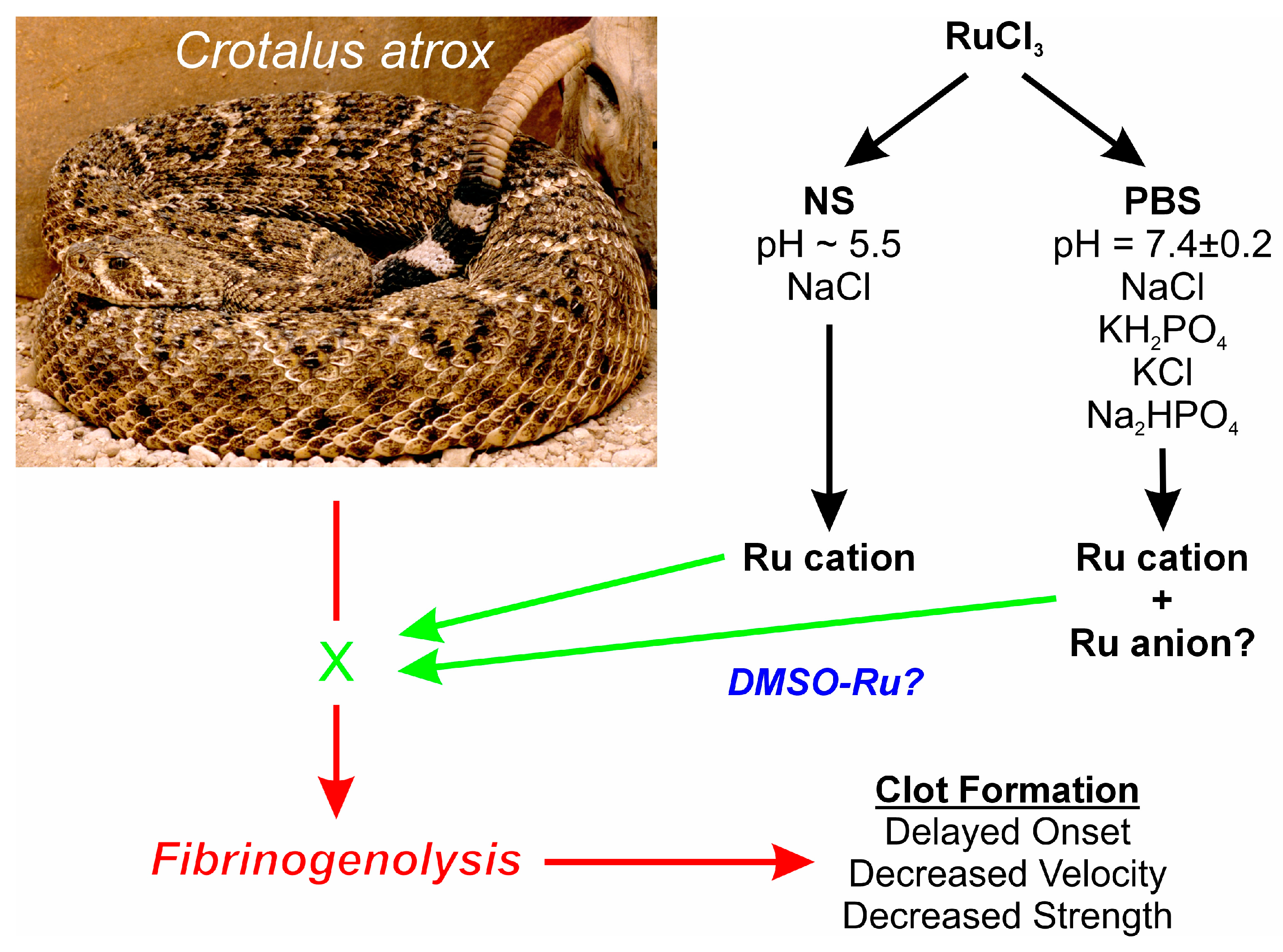
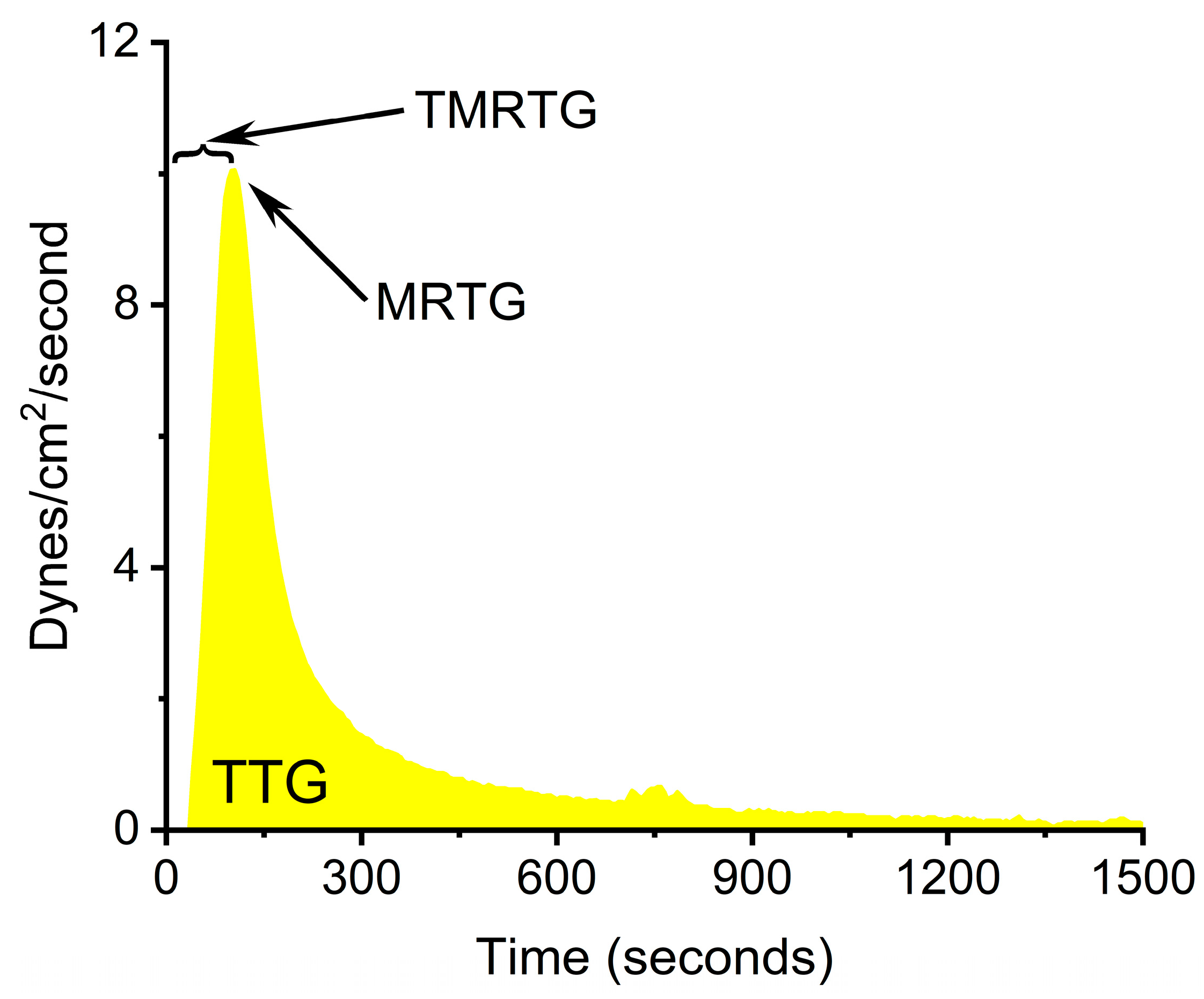
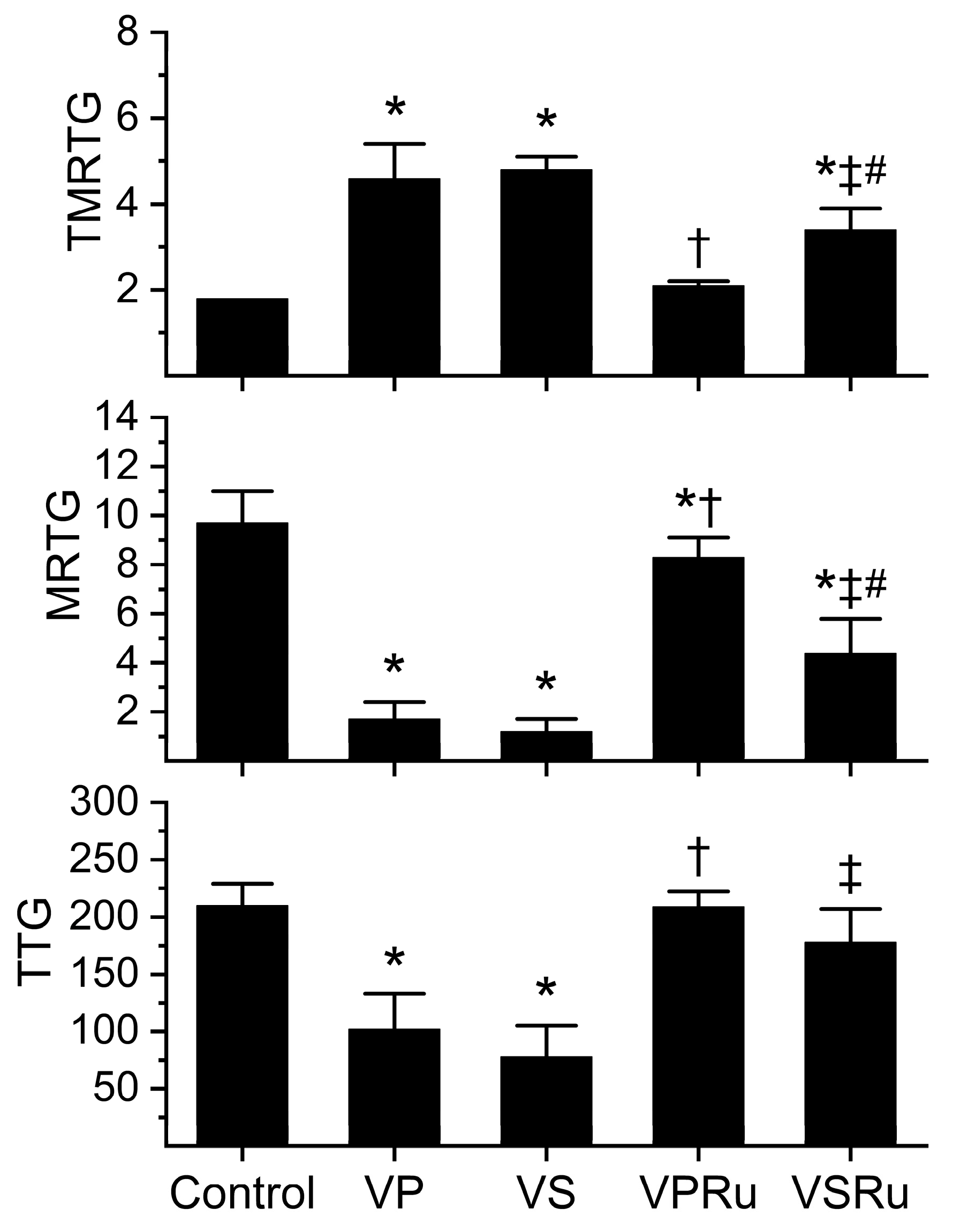
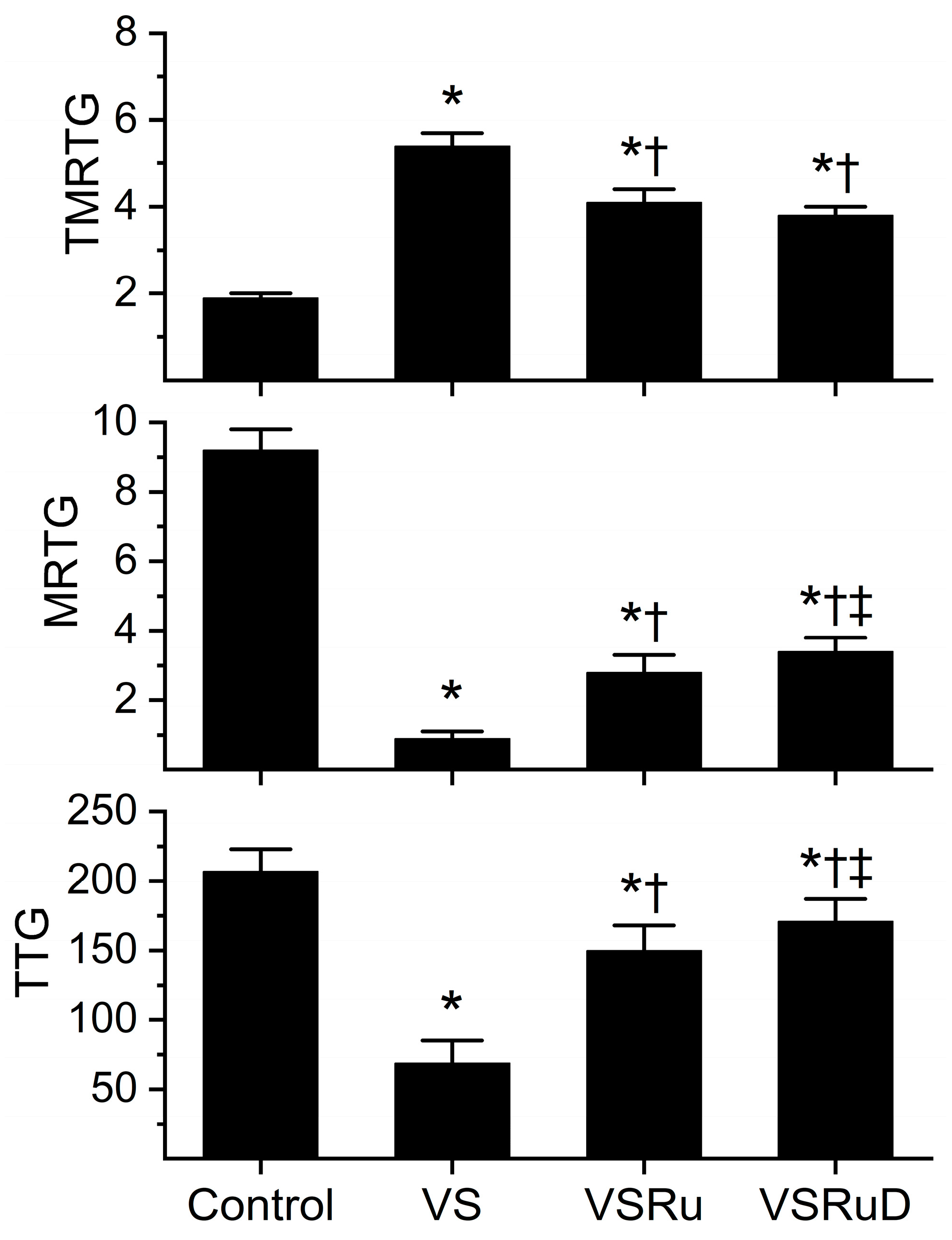
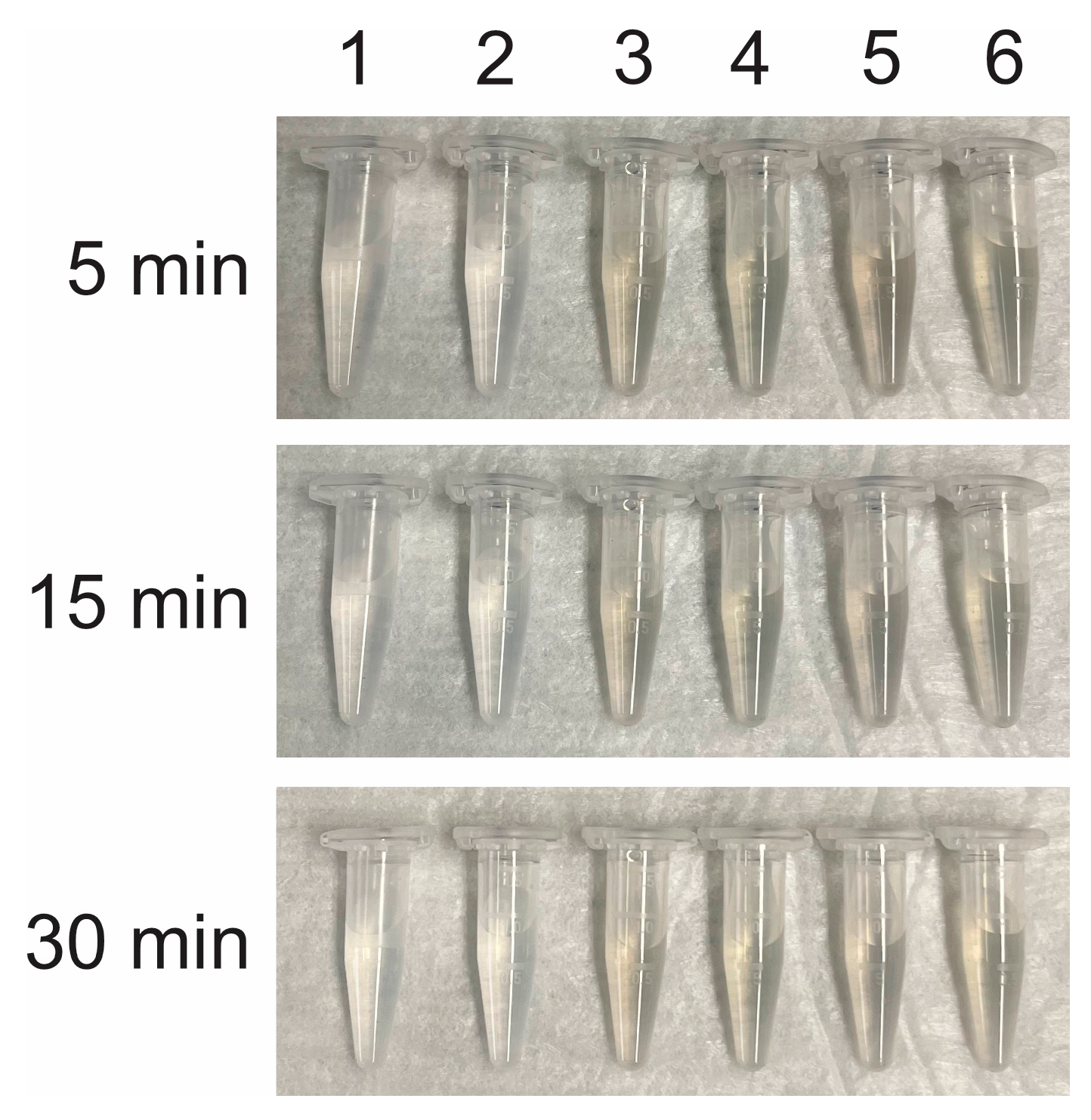
Disclaimer/Publisher’s Note: The statements, opinions and data contained in all publications are solely those of the individual author(s) and contributor(s) and not of MDPI and/or the editor(s). MDPI and/or the editor(s) disclaim responsibility for any injury to people or property resulting from any ideas, methods, instructions or products referred to in the content. |
© 2024 by the author. Licensee MDPI, Basel, Switzerland. This article is an open access article distributed under the terms and conditions of the Creative Commons Attribution (CC BY) license (https://creativecommons.org/licenses/by/4.0/).
Share and Cite
Nielsen, V.G. Phosphate-Buffered Saline and Dimethyl Sulfoxide Enhance the Antivenom Action of Ruthenium Chloride against Crotalus atrox Venom in Human Plasma—A Preliminary Report. Int. J. Mol. Sci. 2024, 25, 6426. https://doi.org/10.3390/ijms25126426
Nielsen VG. Phosphate-Buffered Saline and Dimethyl Sulfoxide Enhance the Antivenom Action of Ruthenium Chloride against Crotalus atrox Venom in Human Plasma—A Preliminary Report. International Journal of Molecular Sciences. 2024; 25(12):6426. https://doi.org/10.3390/ijms25126426
Chicago/Turabian StyleNielsen, Vance G. 2024. "Phosphate-Buffered Saline and Dimethyl Sulfoxide Enhance the Antivenom Action of Ruthenium Chloride against Crotalus atrox Venom in Human Plasma—A Preliminary Report" International Journal of Molecular Sciences 25, no. 12: 6426. https://doi.org/10.3390/ijms25126426
APA StyleNielsen, V. G. (2024). Phosphate-Buffered Saline and Dimethyl Sulfoxide Enhance the Antivenom Action of Ruthenium Chloride against Crotalus atrox Venom in Human Plasma—A Preliminary Report. International Journal of Molecular Sciences, 25(12), 6426. https://doi.org/10.3390/ijms25126426





